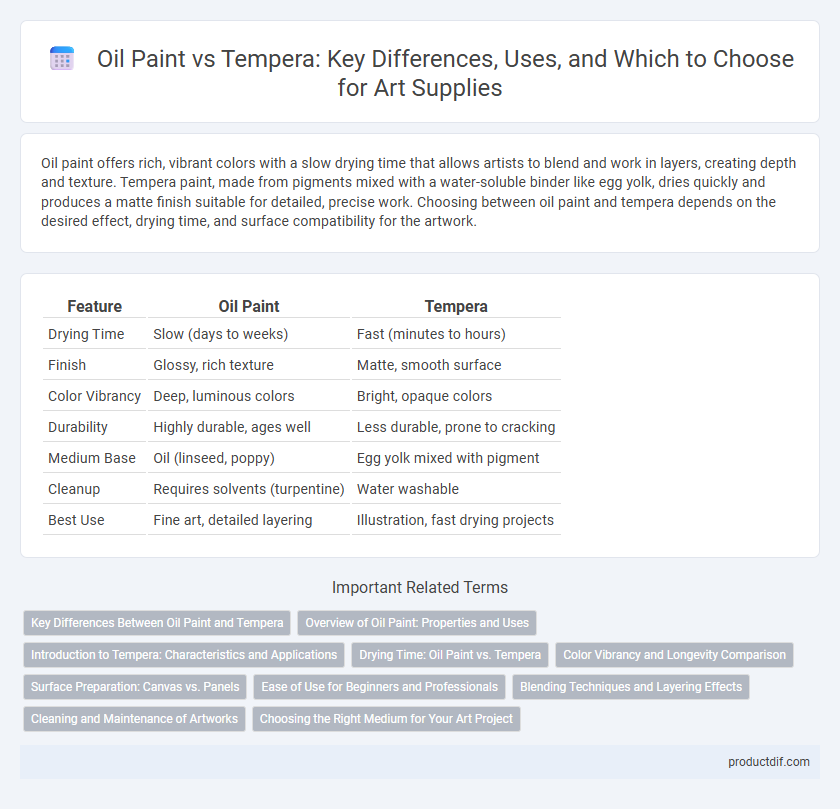Oil paint offers rich, vibrant colors with a slow drying time that allows artists to blend and work in layers, creating depth and texture. Tempera paint, made from pigments mixed with a water-soluble binder like egg yolk, dries quickly and produces a matte finish suitable for detailed, precise work. Choosing between oil paint and tempera depends on the desired effect, drying time, and surface compatibility for the artwork.
Table of Comparison
| Feature | Oil Paint | Tempera |
|---|---|---|
| Drying Time | Slow (days to weeks) | Fast (minutes to hours) |
| Finish | Glossy, rich texture | Matte, smooth surface |
| Color Vibrancy | Deep, luminous colors | Bright, opaque colors |
| Durability | Highly durable, ages well | Less durable, prone to cracking |
| Medium Base | Oil (linseed, poppy) | Egg yolk mixed with pigment |
| Cleanup | Requires solvents (turpentine) | Water washable |
| Best Use | Fine art, detailed layering | Illustration, fast drying projects |
Key Differences Between Oil Paint and Tempera
Oil paint offers rich, vibrant colors with a slow drying time that allows for blending and layering, while tempera dries quickly and provides a matte, opaque finish ideal for fine detail work. Oil paint relies on pigments suspended in oil, creating a flexible, durable surface, whereas tempera uses pigments mixed with egg yolk, resulting in a more brittle and less flexible medium. The longevity and luminosity of oil paintings often surpass tempera, which is favored for its fast-setting properties and archival qualities in early Renaissance art.
Overview of Oil Paint: Properties and Uses
Oil paint is a slow-drying medium made from pigments suspended in oil, offering rich texture, vibrant colors, and excellent blending capabilities. Its durable finish and ability to create depth through layering make it ideal for detailed portraits, landscapes, and fine art techniques. Artists value oil paint for its versatility, long working time, and luminous color retention over centuries.
Introduction to Tempera: Characteristics and Applications
Tempera paint, known for its fast-drying and matte finish, is composed of pigment mixed with a water-soluble binder such as egg yolk, offering exceptional durability and color vibrancy. Commonly used in fine art and iconography, tempera excels in producing detailed, long-lasting artworks due to its excellent adhesion to surfaces like wood panels and paper. Artists value tempera for its precise control, layering capability, and resistance to fading, making it ideal for intricate designs and historical restoration projects.
Drying Time: Oil Paint vs. Tempera
Oil paint dries slowly, often taking days to weeks to fully cure, allowing artists ample time for blending and layering techniques. Tempera, composed mainly of pigment mixed with egg yolk, dries rapidly within minutes to hours, making it ideal for precise, detailed work but less suited for extensive blending. The significant difference in drying time directly impacts the workflow and style choices between oil paint and tempera artists.
Color Vibrancy and Longevity Comparison
Oil paint exhibits superior color vibrancy due to its slow drying time, allowing pigments to blend deeply and create rich, luminous hues that maintain their intensity over centuries. Tempera, composed of pigment mixed with egg yolk, dries quickly and produces a matte finish with less saturation, often leading to a more muted color palette. While tempera artwork ages with less cracking and is less prone to yellowing, oil paint traditionally offers greater longevity and sustained vibrancy when properly preserved.
Surface Preparation: Canvas vs. Panels
Oil paint requires a primed canvas or rigid panels like wood or Masonite to prevent absorption and ensure proper adhesion. Tempera paint performs best on rigid, absorbent surfaces such as wood panels, which provide stability and control over drying time. Proper surface preparation, including sealing and sanding panels or applying gesso to canvas, is essential for both mediums to achieve optimal texture and longevity.
Ease of Use for Beginners and Professionals
Oil paint offers a slower drying time, allowing both beginners and professionals to blend colors seamlessly and correct mistakes more easily, which enhances control during the creative process. Tempera, known for its fast drying speed, requires quick application and precision, making it more challenging for beginners while favored by professionals skilled in fast layering techniques. The choice between oil paint and tempera ultimately depends on the artist's desired working pace and comfort with drying times.
Blending Techniques and Layering Effects
Oil paint offers superior blending techniques due to its slow drying time, allowing artists to create smooth gradients and subtle color transitions. Tempera, with its fast drying nature, requires precise layering effects, resulting in distinct, matte finishes that emphasize texture and crisp edges. The choice between oil and tempera significantly impacts the depth and luminosity achievable through blending and layering in artwork.
Cleaning and Maintenance of Artworks
Oil paint requires solvents such as turpentine or mineral spirits for cleaning brushes and removing paint residues, while tempera, being water-based, can be cleaned easily with soap and water. Oil paint artworks demand careful maintenance to prevent cracking and yellowing, often needing varnish to protect the surface, whereas tempera paintings are more prone to damage from moisture and require framing under glass for preservation. Proper cleaning and maintenance significantly extend the lifespan of oil paint, while tempera's delicate nature necessitates gentle handling and controlled environmental conditions.
Choosing the Right Medium for Your Art Project
Oil paint offers rich texture and vibrant colors, making it ideal for projects that require blending and gradual drying times. Tempera dries quickly and provides a matte finish, suitable for detailed work and vibrant, opaque layers. Selecting the right medium depends on your desired drying time, finish, and the type of surface you plan to work on.
Oil Paint vs Tempera Infographic

 productdif.com
productdif.com